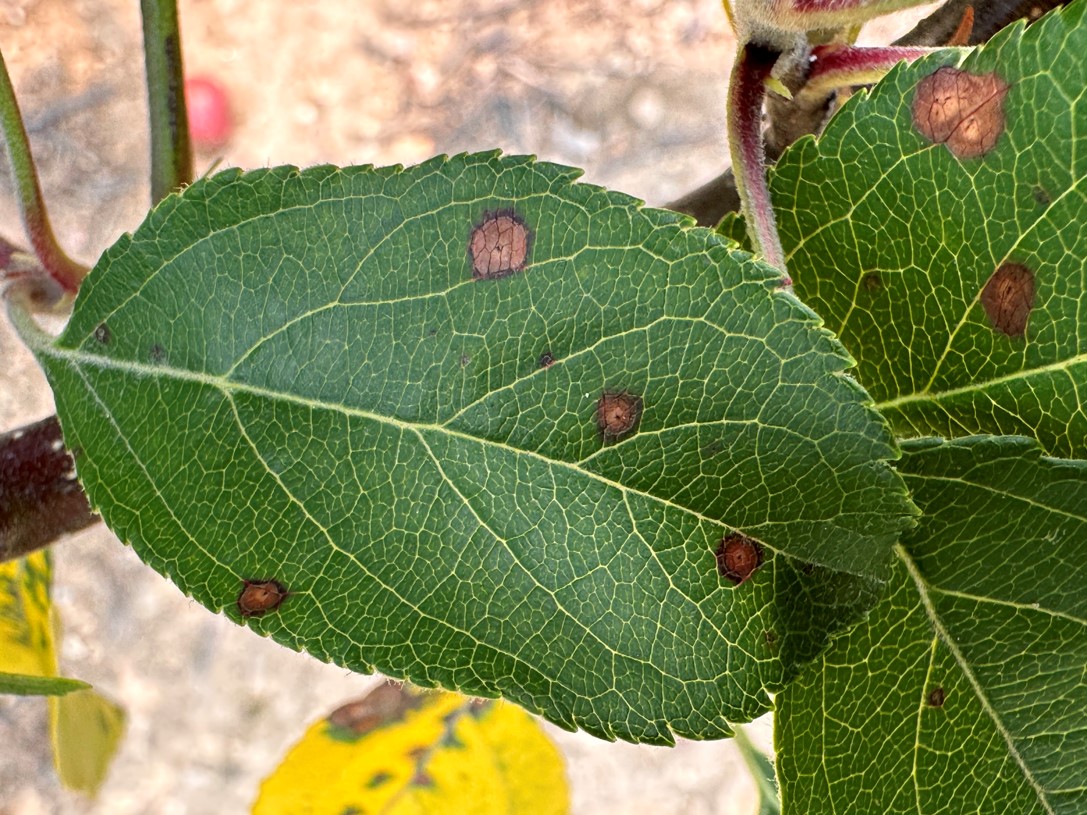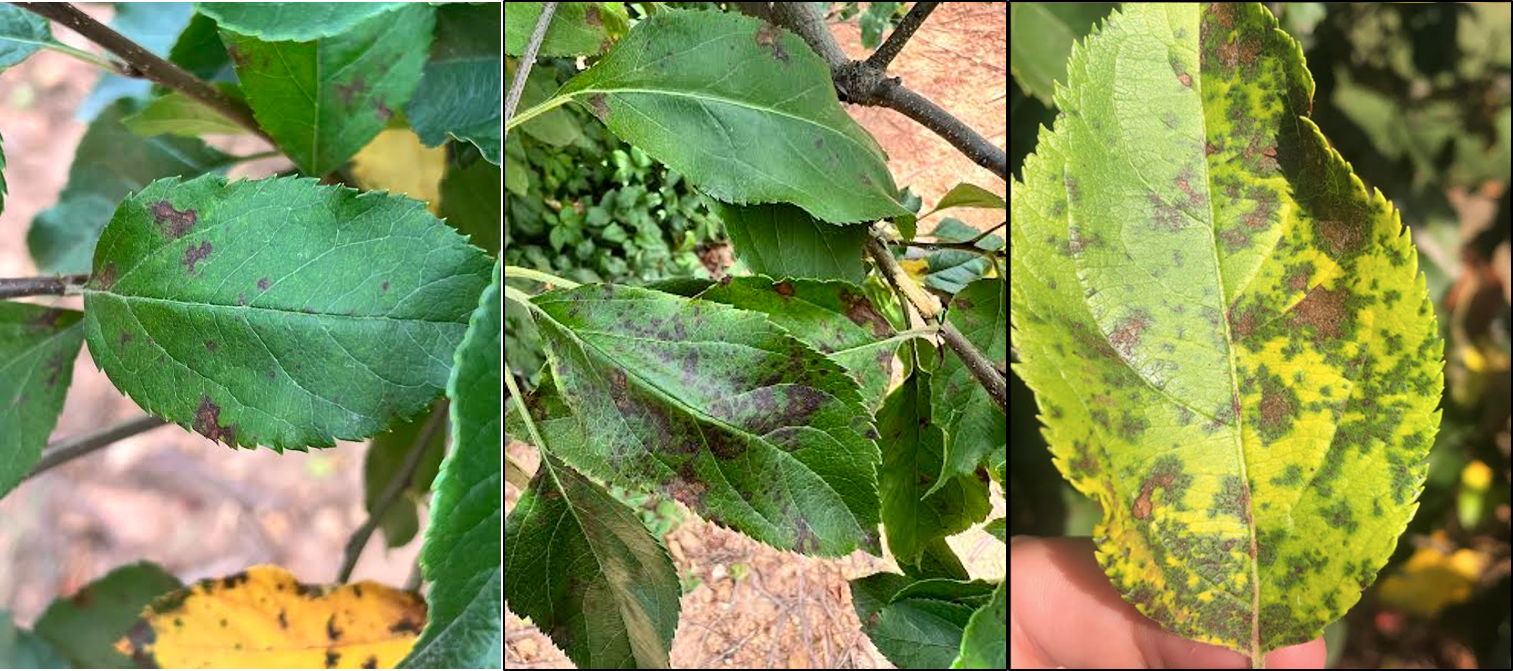Apple Disease Update: Week of July 17, 2023
go.ncsu.edu/readext?946171
en Español / em Português
El inglés es el idioma de control de esta página. En la medida en que haya algún conflicto entre la traducción al inglés y la traducción, el inglés prevalece.
Al hacer clic en el enlace de traducción se activa un servicio de traducción gratuito para convertir la página al español. Al igual que con cualquier traducción por Internet, la conversión no es sensible al contexto y puede que no traduzca el texto en su significado original. NC State Extension no garantiza la exactitud del texto traducido. Por favor, tenga en cuenta que algunas aplicaciones y/o servicios pueden no funcionar como se espera cuando se traducen.
Português
Inglês é o idioma de controle desta página. Na medida que haja algum conflito entre o texto original em Inglês e a tradução, o Inglês prevalece.
Ao clicar no link de tradução, um serviço gratuito de tradução será ativado para converter a página para o Português. Como em qualquer tradução pela internet, a conversão não é sensivel ao contexto e pode não ocorrer a tradução para o significado orginal. O serviço de Extensão da Carolina do Norte (NC State Extension) não garante a exatidão do texto traduzido. Por favor, observe que algumas funções ou serviços podem não funcionar como esperado após a tradução.
English
English is the controlling language of this page. To the extent there is any conflict between the English text and the translation, English controls.
Clicking on the translation link activates a free translation service to convert the page to Spanish. As with any Internet translation, the conversion is not context-sensitive and may not translate the text to its original meaning. NC State Extension does not guarantee the accuracy of the translated text. Please note that some applications and/or services may not function as expected when translated.
Collapse ▲In the past few weeks I’ve had a lot of questions come my way regarding leaf spots on apple. Well, I’ve become much more proficient and confident in making a visual diagnosis, I’ll sometimes get a sample that forces us to get Petri dishes out and the PCR machine fired up. Usually when I am asked about an apple leaf spot issue, my first questions are: 1. What’s the cultivar? and 2. When did you begin to notice symptoms? In NC, the 4 most common leaf spots I see and that are frequently misdiagnosed are i) Frogeye leaf spot (see photo above), ii) Alternaria leaf spot; iii) Glomerella leaf spot, and iv) Marssonina leaf blotch. Certainly in orchards not receiving regular fungicide applications you may come across apple scab or apple rust lesions as well. Below I’ve given brief overviews of each leaf spot to assist you in diagnosis and management. At the end of the post is a quick note on GLS/bitter rot updates and spray programs.
Frogeye leaf spot
- Pathogen: Botryosphaeria obtusa (same pathogen that causes black rot on fruit and cankers in woody tissue in older apple trees)
- Symptoms: Begins as small purple flecks (early symptoms) advancing to circular lesions with purple margins with a dark spot in the center. Sometimes lesions might merge together (see blue arrow above. The purple flecks in that photos are actually early Marssonina blotch symptoms). As lesions advance, they may become more gray in color. If symptoms are severe, leaves will be become chlorotic and abscise prematurely.
- Cultivars most affected: To my knowledge all cultivars commonly grown here are susceptible, but there are varying degrees of susceptibility. An overwintering location of the black rot pathogen are fruit mummies so those that tend to retain mummies more, such as Fuji, often are regarded as more susceptible.
- When to start scouting: Usually around petal fall but I’ve seen symptoms during the early bloom period.
- When to spray: No later than tight cluster. Continue throughout the season
- Effective fungicides: Captan, FRAC 11 (e.g. Luna Sensation, Flint Extra, Merivon), Topsin (thiophanate-methyl). My preference is to include T-methyl with mancozeb and scab fungicides (DMIs and/or SDHIs) until you start spraying strobilurins (FRAC 11) or Captan for GLS/bitter rot.
Alternaria leaf spot
- Pathogen: Alternaria mali
- Symptoms: Brown/tan circular lesions with purple margins or halos. Most often the purple margin is not as pronounced as with frogeye leaf spot and the center of the lesion is a bit wider than the pointed center of frogeye lesions. With severe infections, premature defoliation
- Cultivars most affected: Red Delicious
- When to start scouting: Late spring/early summer (e.g. mid-June)
- When to spray: Around second cover (~21 days after petal fall). Make another 2 or 3 fungicide applications on ~10 day intervals. I often suggest having a separate ‘Red Delicious fungicide program’ because you want to make at least two strobilurin applications during this period and this may differ from strobilurin timing for GLS-susceptible cultivars.
- Effective fungicides: Captan and FRAC 11 (e.g. Luna Sensation, Flint Extra, Merivon, Pristine). Red mites also exacerbate Alternaria severity so make sure to scout and apply a mitecide as necessary.
Glomerella leaf spot (GLS)
- Pathogen: Colletotrichum chrysophilum; Colletotrichum fructicola
- Symptoms: Small purple flecks (see left photo) that expand into irregularly shaped lesions with wavy or concentric rings. Leaves become chlorotic (middle photo) and premature defoliation may occur if not managed properly (right photo-July 2020)
- Cultivars most affected: Cultivars with ‘Golden Delicious’ parentage (e.g. Gala, Pink Lady, Golden Delicious, Jonagold) and ‘Granny Smith’
- When to start scouting: As early as the end of May in NC
- When to spray: Applications targeting GLS should commence around petal fall/first cover. In years with cooler springs, no later than 2nd cover.
- Effective fungicides: Mancozeb, captan, and fungicides containing a strobiluring/FRAC 11 fungicide. (e.g. Luna Sensation, Flint Extra, Merivon, Pristine) Aprovia (FRAC 7) and Omega provide moderate activity. MUST APPLY ON A 7 to 10 DAY INTERVAL.
Marssonina leaf blotch
- Pathogen: Diplocarpon coronariae
- Symptoms: Early symptoms of MLB are diffuse purple specks (left photo), which quickly expand throughout the leaf (middle). As the disease progresses, lesions remain diffuse, and are brown and irregular in appearance.
- Cultivars most affected: All, but varying levels of susceptibility. ‘Rome Beauty’ seems to be a poster child in NC, perhaps likely due to the fact they are less intensely managed with fungicides compared to cultivars highly susceptible to GLS and bitter rot.
- When to start scouting: Early to mid-July in NC
- When to spray: Based on our research in NC, applications targeting MLB should begin around petal fall and continue through fourth cover (~ on an ~ 7-14 day interval. After the 4th cover application, continue biweekly fungicide applications of a multi-site protectant (e.g. captan) through harvest.
- Example effective fungicides: Cevya (only fungicide in USA labeled for this disease), Merivon, Sercadis, Inspire Super, captan
What Fungicides to Apply this Week
- Continue to apply captan on a 7 to 10 day interval. I’ve been seeing some flyspeck and sooty blotch pop up so consider including thiophanate-methyl (e.g. Topsin) if there’s any concern. You should have already applied at least two Merivon applications this season. If not or you’re thinking about applying a third, with the heat and the break through thunderstorms this week, considering adding Merivon to the tank mix.







